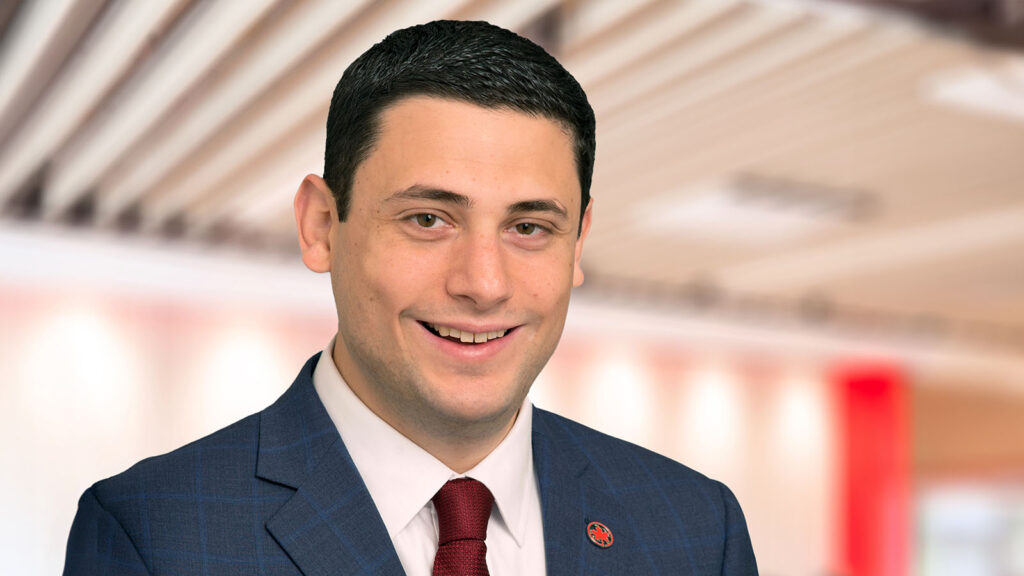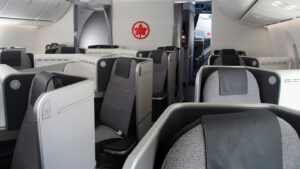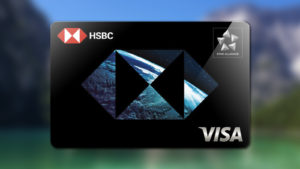Air Canada Aeroplan is growing in Australia, but not forcefully: Mark Nasr
Nasr is a fount of knowledge on loyalty programs, even beyond Aeroplan itself.

What we'll be covering
EXCLUSIVE INTERVIEW | There’s a lot happening at Air Canada, with flights soaring to Sydney and Brisbane, and Melbourne potentially on the horizon. For clued-in frequent flyers, Air Canada’s Aeroplan program is also gearing up on value, with a new points transfer partnership among many recent initiatives. Steering the ship on the loyalty front is Mark Nasr, President of Aeroplan.
Along with running the carrier’s frequent flyer program, Nasr is also Air Canada’s Executive Vice President of Marking and Digital. As it happens, he’s an avid Point Hacks reader to boot.
‘We respect very much the quality of the work and the writing,’ Nasr says as we settle in for an extended catch-up. Speaking on the sidelines of this year’s invitation-only IATA AGM, we escape to the Executive Lounge at the JW Marriott Marquis Dubai for our chat.
Before we begin, Nasr comments on a recent flight review of mine, during which I happened to eat a purple Hawaiian taro roll. ‘As you can tell, down to (remembering) the purple bread and memorising your photos, it’s a pleasure to talk.’ Thank you Mark, let’s get to it!
Nasr on Aeroplan’s positioning in the Aussie market
Canada is naturally Aeroplan’s home market. But like most frequent flyer programs, Aeroplan commands an international following. Outside of Canada, the next-largest focus is the United States – which also probably comes as no surprise. But it seems, Australia punches above its weight within Air Canada’s many international markets.
‘Australia is one of the markets where we actually have our own local customer base,’ Nasr shares. ‘Relative to the size of Air Canada, we have a very big presence there.’ But even so, Aeroplan isn’t actively driving significant growth Down Under. It seems, Nasr is being very mindful of Air Canada’s partnerships and is putting those ahead of any self-interest.
‘On the one side we’re very happy to have Aussie members. We think it’s actually a pretty compelling value proposition because there’s Star Alliance, plus Virgin Australia, plus Emirates, which is a strong combination for Aussies and Kiwis. But at the same time, we’re not actually looking to build a local base of members and compete locally.’
That’s ‘simply because we really enjoy our partnerships down there. So to the extent to which the program has the relevancy locally, that’s great and members want to engage in it. But it’s certainly not a bread-and-butter, kitchen table program meant broadly for Aussies. But they’re most welcome in.’
That said, Aeroplan is participating in the HSBC Star Alliance Credit Card. This allows Aussies to easily amass Aeroplan points on credit card spends and fast-track to Star Alliance Gold status with Air Canada. So, Aeroplan isn’t totally taking a back seat.
‘It’s an interesting product,’ Nasr reflects. ‘It’s a bit of a test for us. Star Alliance was keen on doing it and Singapore Airlines is very strong in the market. They wanted to have a solution but didn’t want to go it alone, so it became an alliance product.’
Aeroplan’s points transfer partners
Beyond the Star Alliance Credit Card, Aeroplan has also recently inked a points transfer partnership with PayRewards. That’s the loyalty program of pay.com.au (affiliated with Point Hacks), with points convertible to Aeroplan at a 2.5:1 rate. As well, it’s possible to convert CommBank Awards points into Aeroplan points, albeit at a 4:1 rate.
It’s fair to say, that conversion rate from CBA isn’t ideal. Particularly when CommBank uses a 2:1 rate on transfers from most cards to Velocity, and 3:1 to Singapore Airlines KrisFlyer. So why is CBA’s conversion rate so high, and is that likely to change?
‘It’s really a question for the Commonwealth Bank,’ Nasr says. ‘I would presume that it would be related to the economics that we have with them. I can’t see another reason. Certainly, our position isn’t forcing a certain conversion ratio. Aeroplan points are, we believe, the most valuable airline points in the world. Certainly, the commercials that we have in Australia and in other markets reflect what we think the value of the currency is.’
Speaking more generally, Nasr shares that ‘typically, exchange rates on transferable currencies are related to the individual commercials around the rates.’ But while we’re on the subject of transferrable points, might Aeroplan be looking to add even more options in Australia? For instance, by enabling points transfers from American Express Membership Rewards?
‘Might we do more in the market? Potentially. But we’re going to do it carefully. And we’re going to do it where we think it’s an appeal to customers that have some frequency (of travel) to North America. But we’re not looking at building, as I said, like a bread-and-butter broad spec program in Australia.’
‘Velocity is an outstanding partner,’ says Nasr
For many Australians, Velocity Frequent Flyer remains the easiest way to earn and spend points on Air Canada flights. The partnership has also evolved to include reciprocal lounge access for eligible frequent flyers. But that’s the only method of status recognition available between the two carriers.
Velocity Gold and Platinum members flying Air Canada Economy Class, for instance, receive no other benefits. There’s no priority check-in, no priority security, no priority boarding and no additional baggage allowance. Given how many years the two airlines have been joined, this remains a frustrating sticking point of the tie-up.
‘Velocity’s an outstanding partner. I’d say first of all, we’re thrilled to be partnered with Virgin,’ Nasr continues. ‘We also feel that it’s a good relationship because we fill in spaces for one another very clearly. They obviously don’t have their transpacific or their wide body service anymore. We’re very happy to provide that utility to their members both for cash and for points.’
‘Likewise, we have all this capacity in Australia and New Zealand, and we’re very happy to have the connectivity to reach the rest of the country. We’ve expanded the relationship to the lounges. We’re working on additional areas of premium passenger comfort and frequent flyer elite member convenience and services to better integrate the value proposition.’
Nasr doesn’t give a timeline for the above. As of October 2024, reciprocal elite benefits other than lounge access remain unavailable. For clarity, Velocity members also receive no lounge access via their Velocity status when flying from Australia to Vancouver. Access is instead only available at airports where Air Canada operates an own-brand Maple Leaf Lounge.
What’s holding up those benefits with Velocity?
As it happens, Air Canada’s IT systems can’t currently detect the Velocity status of a travelling passenger. Even when an elite Velocity number is entered onto a booking, the system still treats the passenger as a no-status flyer. I have a hunch that the biggest holdup to members enjoying benefits stems from the tech side of things, rather than the airlines deliberately withholding perks from members. Tell me Mark, am I right?
‘You’re a hundred percent correct,’ Nasr says. Aeroplan and Velocity ‘took a look at it and we said, we want consistency of the service. The only way to have consistency for networks of our size is if it’s delivered systematically.’ Translation: the computer needs to recognise the traveller’s status, rather than have them fighting for benefits every step of the way.
‘There are pros and cons to being an alliance. One of the pros is that you get these solutions that work alliance wide. One of the cons is if you’re working with someone outside the alliance, then everything’s custom built. And with Virgin, there are two considerations there. One is they’re not in Star. The other is they’re on Sabre (and) we’re on Amadeus.’ (Sabre and Amadeus are Global Distribution Systems: IT platforms that underpin airline ticket sales and reservations).
‘So that’s something that needs to be built, but something we are working on now. It’s about reciprocating and being able to offer to Velocity members and likewise to Aeroplan.’
When asked whether Air Canada could adapt the work done by its partner United Airlines with regard to Velocity, unfortunately, it’s not that simple. ‘United, for example, is in a different reservation system then even we are,’ Nasr lists as just one reason why that wouldn’t work.
While there’s work to do on the IT front Down Under, Nasr tips something else on the horizon for Air Canada. That’s resuming direct flights between Vancouver and Melbourne. ‘Melbourne, we haven’t brought back … but it’s on the list in the future, once we get some (more) aircraft.’
Also read: Air Canada eyes a return to Melbourne
Featured image courtesy of Air Canada. Chris Chamberlin attended the IATA AGM in Dubai as a guest of IATA.
Stay up to date with the latest news, reviews and guides by subscribing to Point Hacks’ email newsletter.






Business Class New York JFK to Toronto – no priority security, no lounge at JFK, the onboard catering was 1 out of 10 (a stale bread roll). The cabin crew apologised for the below-average meal by saying they don’t have catering at JFK. Once we arrived in Toronto, the people picking us up said we won’t fly Air Canada. Points are only worth as much as the service you get even though we paid cash for the tickets.
Nothing in there (including the many excuses) suggests any change to that.
Aeroplan obviously has some sweet spot value in their award charts, many partners (so good availability), and a generous stopover policy.
If they keep those things as a point of difference, they’re a very compelling option.